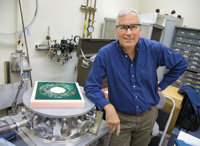Commentary: Jim Siegrist
Forging ahead toward the frontiers
Its a challenging time for particle physics in the United States. The outlook for federal spending for physics research—indeed for all of science—is uncertain. For the first time in decades, there is no particle collider for high-energy physics operating or under construction on US soil. In the midst of fierce international competition in neutrino physics, the future of the Long-Baseline Neutrino Experiment remains unclear. And in the midst of this time of uncertainty I stepped into the role of director for the Department of Energys Office of High Energy Physics. You might wonder: why?
I took the job because I believe that a strong US particle physics research program is vitally important for the nation, and for the world. This program must be diverse in order to best position our community to make the next major discoveries and to follow where they lead. It must keep the US a leader in the field, to keep the balance between the major world regions and ensure a steady flow of new talent and ideas to US physics institutions. It must restore a healthy balance between funding for R&D, construction, and operations, so we can be ready to build and exploit the facilities necessary to take advantage of new discoveries.
The US was the birthplace of particle accelerators and today boasts the largest single community of particle and accelerator physicists in the world. Congress, recognizing the importance of particle physics and accelerator science to our country, directed DOE in its 2012 budget to deliver within nine months two strategic plans: one for particle physics with intense beams and a second for advanced accelerator R&D.
My colleagues and I in the Office of High Energy Physics have a busy year ahead, working with the US physics community to devise long-term strategies for those two areas while ensuring a balanced portfolio of research at the energy, intensity, and cosmic frontiers of particle physics.
The 2008 report of the Particle Physics Project Prioritization Panel planted the seeds of a future national program with high-intensity particle beams, but the physics community did not subsequently explore the full scope of a US intensity frontier program. We have begun this process with a DOE-hosted workshop and are now in the process of translating the communitys consensus on scientific opportunities and required facilities into a long-term strategy.
The past few years have seen an increasing focus in Washington on research that has immediate impact on problems of great national importance. Our basic research program is valued by decision makers of all political stripes, but theres no denying that broader support is possible when we can articulate the impact of our research on society. The Office of High Energy Physics is working closely with the broader scientific community—nuclear physics, light source communities, computing science—to create and implement a strategy that will transform breakthroughs in accelerator R&D to advances that benefit both science and society in the short and long term.
A strong future for particle physics in the United States will require hard work on the part of everyone involved with our field. Our community of particle physicists will need to come together to achieve consensus on the direction our country should take at the Intensity Frontier. The accelerator science community will need to form partnerships with other fields and industries to transform our innovative ideas to the benefit of society. And my colleagues and I in the Office of High Energy Physics will work within available budgets to implement the best possible scientific program for our nation and the world.
Jim Siegrist is the director of the Office of High Energy Physics in the Department of Energys Office of Science.
Click here to download the pdf version of this article.



